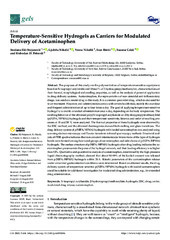| dc.description.abstract | The purposes of this study are the polymerization of temperature-sensitive copolymers based on N-isopropyl acrylamide and 10 mol % of 2-hydroxypropylmethacrylate, characterisations of their thermal, morphological and swelling properties, as well as the analysis of potential application in drug-delivery systems. Acetaminophen, the representative of non-steroidal anti-inflammatory drugs, was used as a model drug in this study. It is a common pain relief drug, which is also used for fever treatment. However, oral administration comes with certain health risks, mainly the overdose and frequent administration of up to four times a day. The goal of applying temperature-sensitive hydrogel is to enable extended administration once a day, depending on the body temperature. The swelling behavior of the obtained poly(N-isopropyl acrylamide-co-2-hydroxypropylmethacrylate) (p(NIPA/HPMA)) hydrogels and their temperature-sensitivity, kinetics and order of swelling processes at 18 and 38 °C were analyzed. The thermal properties of these hydrogels were observed by the DSC method, and the obtained thermograms showed both melting and glass transitions. The drug delivery system of p(NIPA/HPMA) hydrogels with loaded acetaminophen was analyzed using scanning electron microscopy and Fourier transform infrared spectroscopy methods. Structural analysis of FTIR spectra indicates that non-covalent intermolecular interactions of the type of hydrogen bonds were formed among functional groups of acetaminophen and side-chains of p(NIPA/HPMA) hydrogels. The surface structure of p(NIPA/HPMA) hydrogels after drug loading indicates the acetaminophen presence into the pores of the hydrogel network, and their loading efficiency was higher than 92%. Qualitative and quantitative analysis of acetaminophen, determined by the high-pressure liquid chromatography method, showed that about 90–99% of the loaded amount was released from p(NIPA/HPMA) hydrogels within 24 h. Kinetic parameters of the acetaminophen release under simulated gastrointestinal conditions were determined. Based on obtained results, the drug delivery system of temperature-sensitive p(NIPA/HPMA) hydrogels with loaded acetaminophen could be suitable for additional investigation for modulated drug administration, e.g., for extended drug administration. | sr |

